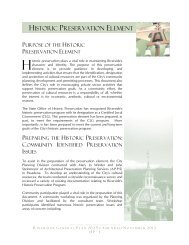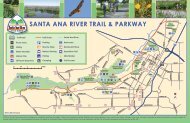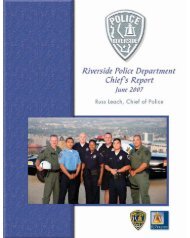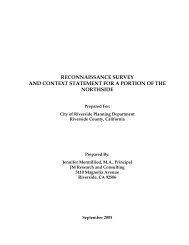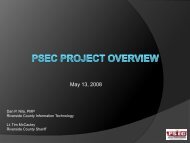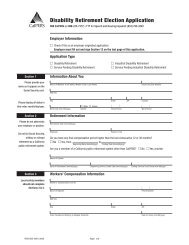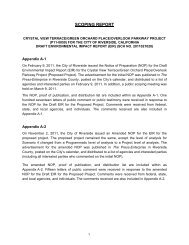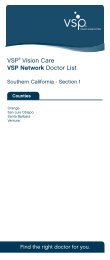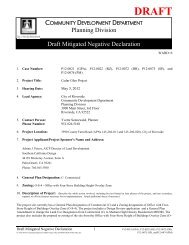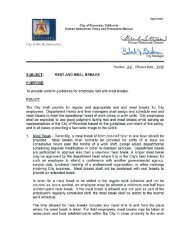Airport Master Plan - City of Riverside
Airport Master Plan - City of Riverside
Airport Master Plan - City of Riverside
Create successful ePaper yourself
Turn your PDF publications into a flip-book with our unique Google optimized e-Paper software.
medium sized business jets, and one<br />
mile for large business jets. This approach<br />
also has a VOR approach,<br />
which utilizes the <strong>Riverside</strong> VOR. Because<br />
this VOR facility is currently<br />
inoperable, the VOR only approach is<br />
not available.<br />
The RNAV (GPS) approach to Runway<br />
27 <strong>of</strong>fers visibility minimums not lower<br />
than one and one-half miles. The<br />
LPV approach to Runway 27 provides<br />
both horizontal and vertical guidance.<br />
Several alternate GPS approaches, including<br />
lateral navigation/vertical navigation<br />
(LNAV/ VNAV), an LNAV only,<br />
and a circling approach, are also<br />
available with this approach.<br />
The last two approaches are GPS-A<br />
and GPS-B. The GPS-A approach is a<br />
circling approach to Runway 9-27<br />
while the GPS-B approach is a circling<br />
approach to Runway 16-34. The VOR<br />
approach associated with this procedure<br />
is also unavailable currently.<br />
Arrival Procedures<br />
Because <strong>of</strong> the possibility <strong>of</strong> congested<br />
airspace over the greater Southern<br />
California area, the FAA has established<br />
a series <strong>of</strong> Standard Terminal<br />
Arrival (STAR) and Departure Procedures.<br />
The STAR is a preplanned air<br />
traffic control arrival procedure designed<br />
to provide for the transition<br />
from the enroute phase <strong>of</strong> the flight to<br />
an outer fix or an instrument approach<br />
fix in the terminal area. The<br />
two published STARs are: SETER<br />
TWO and ZIGGY FOUR.<br />
Local Conditions<br />
and Operating Procedures<br />
<strong>Riverside</strong> <strong>Airport</strong> is situated at 818<br />
feet MSL. The traffic pattern altitude<br />
for all light aircraft is 1,000 feet AGL.<br />
The traffic pattern for highperformance<br />
aircraft, including jetpowered<br />
aircraft, is at 1,500 feet AGL.<br />
The helicopter traffic pattern is designated<br />
at 500 feet AGL. The airport<br />
utilizes a non-standard right-hand<br />
traffic pattern for Runway 16 and<br />
standard left-hand traffic pattern for<br />
all other runways. This traffic pattern<br />
for Runway 16 is intended to avoid the<br />
high volume <strong>of</strong> approaches to Runway<br />
27.<br />
Runway use is dictated by prevailing<br />
wind conditions. Ideally it is desirable<br />
for aircraft to land directly into the<br />
wind. The prevailing wind condition<br />
during the day is from the west leading<br />
to greater usage <strong>of</strong> Runway 27.<br />
Easterly winds predominate at night,<br />
dictating the use <strong>of</strong> Runway 9. Wind<br />
flows from the north occur approximately<br />
two percent <strong>of</strong> the time, which<br />
requires use <strong>of</strong> Runway 34. Runway<br />
16 is generally not used, and Runway<br />
9 is the designated calm wind runway.<br />
Tower personnel estimate that Runway<br />
27 is utilized nearly 90 percent <strong>of</strong><br />
the time and Runway 16-34 will see<br />
some activity in the spring and fall.<br />
The FAA <strong>Airport</strong>/Facility Directory<br />
identifies several conditions for pilots<br />
to be aware <strong>of</strong> in the vicinity <strong>of</strong> the<br />
airport. There is a 60-foot tall utility<br />
pole approximately 1,920 feet north <strong>of</strong><br />
Runway 16 and 150 feet right <strong>of</strong> the<br />
1-18



